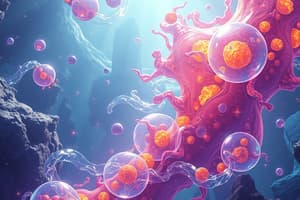Podcast
Questions and Answers
What is the primary means of moving substances across a membrane in active transport?
What is the primary means of moving substances across a membrane in active transport?
- Exocytosis
- Active transport (correct)
- Diffusion
- Osmosis
Which type of active transport involves the movement of ions across a membrane, creating a difference in charge?
Which type of active transport involves the movement of ions across a membrane, creating a difference in charge?
- Osmosis
- Bulk transport
- Secondary active transport
- Primary active transport (correct)
What drives the movement of biomolecules like amino acids and glucose across a membrane in secondary active transport?
What drives the movement of biomolecules like amino acids and glucose across a membrane in secondary active transport?
- Osmosis
- Bulk transport
- Simple diffusion
- Primary active transport of ions (correct)
What type of transport involves larger molecules and particles being encased in vesicles to enter or leave the cell?
What type of transport involves larger molecules and particles being encased in vesicles to enter or leave the cell?
What is the main difference between tonicity and osmolarity?
What is the main difference between tonicity and osmolarity?
What happens to a cell in a hypertonic solution?
What happens to a cell in a hypertonic solution?
What process involves removing waste materials from the cell into the extracellular fluid?
What process involves removing waste materials from the cell into the extracellular fluid?
Which type of endocytosis involves the cell ingesting or engulfing large particles using its cell membrane?
Which type of endocytosis involves the cell ingesting or engulfing large particles using its cell membrane?
In which type of solution will a cell tend to swell and eventually burst?
In which type of solution will a cell tend to swell and eventually burst?
Flashcards are hidden until you start studying
Study Notes
Active Transport
- The primary means of moving substances across a membrane in active transport is the use of energy, often in the form of ATP.
- Electrochemical gradient-based active transport involves the movement of ions across a membrane, creating a difference in charge.
Secondary Active Transport
- The movement of biomolecules like amino acids and glucose across a membrane in secondary active transport is driven by the electrochemical gradient established by the primary active transport of ions.
Vesicle-Mediated Transport
- Larger molecules and particles enter or leave the cell through vesicle-mediated transport, where they are encased in vesicles.
Osmosis and Toxicity
- Tonicity refers to the effect of a solution on a cell's shape and volume, while osmolarity refers to the concentration of solutes in a solution.
- In a hypertonic solution, a cell will lose water through osmosis, causing it to shrink.
Cell Waste Removal
- The process of removing waste materials from the cell into the extracellular fluid is called exocytosis.
Endocytosis
- Phagocytosis is a type of endocytosis that involves the cell ingesting or engulfing large particles using its cell membrane.
Cell Swelling and Lysis
- In a hypotonic solution, a cell will tend to swell and eventually burst due to the uptake of excess water through osmosis.
Studying That Suits You
Use AI to generate personalized quizzes and flashcards to suit your learning preferences.




